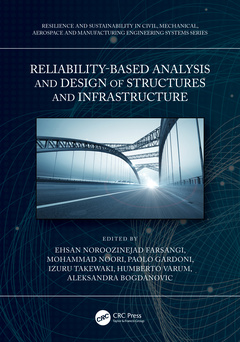Reliability-Based Analysis and Design of Structures and Infrastructure Resilience and Sustainability in Civil, Mechanical, Aerospace and Manufacturing Engineering Systems Series

Increasing demand on improving the resiliency of modern structures and infrastructure requires ever more critical and complex designs. Therefore, the need for accurate and efficient approaches to assess uncertainties in loads, geometry, material properties, manufacturing processes, and operational environments has increased significantly. Reliability-based techniques help develop more accurate initial guidance for robust design and help to identify the sources of significant uncertainty in structural systems. Reliability-Based Analysis and Design of Structures and Infrastructurepresents an overview of the methods of classical reliability analysis and design most associated with structural reliability. It also introduces more modern methods and advancements, and emphasizes the most useful methods and techniques used in reliability and risk studies, while elaborating their practical applications and limitations rather than detailed derivations.
Features:
- Provides a practical and comprehensive overview of reliability and risk analysis and design techniques.
- Introduces resilient and smart structures/infrastructure that will lead to more reliable and sustainable societies.
- Considers loss elimination, risk management and life-cycle asset management as related to infrastructure projects.
- Introduces probability theory, statistical methods, and reliability analysis methods.
Reliability-Based Analysis and Design of Structures and Infrastructure is suitable for researchers and practicing engineers, as well as upper-level students taking related courses in structural reliability analysis and design.
Chapter 1. Reliability-Based Design Optimization.
Chapter 2. Reliability-based Structural Vibration Control.
Chapter 3. Seismic Reliability-Based Design of elastic and inelastic structural systems equipped with seismic devices.
Chapter 4. Why Resilience-Based Design?.
Chapter 5. Resilience Engineering: Principles, Methods and Applications to Critical Infrastructure Systems.
Chapter 6. Resilience Based Design of Buildings.
Chapter 7. Positioning Resilience in Design and Analysis of Structures and Infrastructure.
Chapter 8. Stochastic finite element method.
Chapter 9. Structural Health Monitoring-integrated Reliability Assessment of Engineering Structures.
Chapter 10. Time-dependent reliability of aging structures exposed to imprecise deterioration information.
Chapter 11. Non-linear numerical analyses of reinforced concrete structures: safety formats, aleatory and epistemic uncertainties.
Chapter 12. Risk-based Seismic Assessment of Curved Damper Truss Moment Frame .
Chapter 13. Risk-Target Based Design of base-isolated buildings.
Chapter 14. Structural performance evaluation system for improved building resilience and reliability.
Chapter 15. Line sampling simulation: recent advancements and applications.
Chapter 16. Probabilistic performance analysis of modern RC frame structures subjected to earthquake loading.
Chapter 17. Research on safety assessment and maintenance decision for the metal structure of the casting crane.
Chapter 18. Seismic Risk Based Design for Bridge.
Chapter 19. Maximum entropy method for probabilistic quantification of soil properties: a case study of Nipigon River landslide in Ontario, Canada.
Chapter 20. Advances in Online Decentralized Structural Identification.
Chapter 21. Stochastic optimization methods in machine learning.
Chapter 22. Period-height relationships for the design, assessment and reliability analysis of code-compliant reinforced concrete frames .
Chapter 23. Reliability of the Rehabilitation of the Monumental Buildings in Seismic Regions.
Chapter 24. Reliability Based Analyses and Design of Pipelines Under Ground Movements During Earthquakes.
Chapter 25. Optimal design of hysteretic damper with stopper mechanism for tall buildings under earthquake ground motions of extremely large amplitude.
Chapter 26. Reliability analysis and resilience assessment of substation systems using the state tree method: a framework and application.
Chapter 27. Reliability-Based Methods for Inspection Planning and Predictive Maintenance in Fixed Offshore Structures.
Chapter 28. Load and Resistance Factor Design Involving Random Variables with Unknown Probability Distributions.
Chapter 29. Methods of Moment for System Reliability.
Chapter 30. Reliability-based design optimization using transfer learning.
Dr. Ehsan Noroozinejad Farsangi is currently serving as an A/Professor in the Department of Earthquake and Geotechnical Engineering at the Graduate University of Advanced Technology, Iran. Dr. Noroozinejad is the Founder and Chief Editor of the International Journal of Earthquake and Impact Engineering, the Associate Editor of the ASCE Practice Periodical on Structural Design and Construction, the Associate Editor of the IET Journal of Engineering, the Associate Editor of Frontiers in Built Environment: Earthquake Engineering Section, the Associate Editor of the Open Civil Engineering Journal, the Associate Editor of the Journal of Applied Science and Engineering, the Editor of the Journal of Reliability Engineering and Resilience, and the Trial Engineering Editor of ASCE Natural Hazards Review. He is also the Core member of the FIB Commission on Resilient RC Structures, the ASCE Objective Resilience Committee, the ASCE Risk and Resilience Measurements Committee, the ASCE Civil Infrastructure and Lifeline Systems Committee, the ASCE Structural Health Monitoring & Control Committee, and also the IEEE P693 Committee on Seismic Design for Substations. He has more than 50 journal papers in indexed journals and has published 4 books with reputed publishers in his field of expertise. His main research interests include; structural and geotechnical earthquake engineering, structural dynamics, computational dynamics, smart structures, solid and fracture mechanics, resilience-based design, reliability analysis, artificial intelligence, SSI, and vibration control in structures and infrastructure under extreme loading.
Dr. Mohammad Noori is a professor of Mechanical Engineering at Cal Poly, San Luis Obispo, a Fellow of the American Society of Mechanical Engineering and a recipient of the Japan Society for Promotion of Science Fellowship. Noori’s work in nonlinear random vibrations, seismic
Date de parution : 09-2021
17.8x25.4 cm
Thèmes de Reliability-Based Analysis and Design of Structures and... :
Mots-clés :
Reliability Based Design Optimization; IDA; Fragility Curve; Failure Probability; Limit State Function; Seismic Fragility Curves; Reliability Index; Seismic Design Levels; IDA Curve; Seismic Reliability; RBDO Problem; Seismic Hazard Curves; Cumulative Distribution Function; Seismic Fragility; Seismic Isolation; MR Damper; PC Expansion; Ground Movements; Recovery Function; non-Gaussian Random Field; Subset Simulation; SLS; Hysteretic Dampers; Fragility Functions; Seismic Resilience



